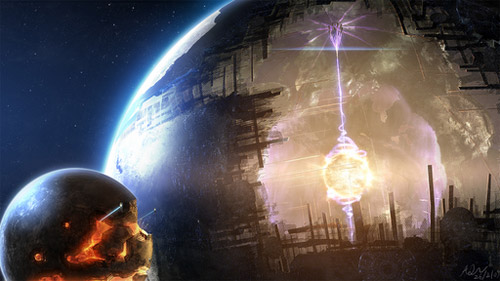RIP Kardashev Civilization Scale
October 30, 2013 5 Comments
In 1964, Soviet astronomer Nikolai Kardashev proposed a model for categorizing technological civilizations. He identified 4 levels or “Types”, simplified as follows:
Type 0 – Civilization that has not yet learned to utilize the full set of resources available to them on their home planet (e.g. oceans, tidal forces, geothermal forces, solar energy impinging upon the planet, etc.)
Type 1 – Civilization that fully harnesses, controls, and utilizes the resources of their planet.
Type 2 – Civilization that fully harnesses, controls, and utilizes the resources of their star system.
Type 3 – Civilization that fully harnesses, controls, and utilizes the resources of their galaxy.
As with philosophical thought, literature, art, music, and other concepts and artifacts generated by humanity, technological and scientific pursuits reflect the culture of the time. In 1964, we were on the brink of nuclear war. The space race was in full swing and the TV show “Star Trek” was triggering the imagination of laymen and scientists alike. We thought in terms of conquering people and ideas, and in terms of controlling resources. What countries are in the Soviet bloc? What countries are under US influence? Who has access to most of the oil? Who has the most gold, the most uranium?
The idea of dominating the world was evident in our news and our entertainment. Games like Risk and Monopoly were unapologetically imperialistic. Every Bond plot was about world domination.
Today, many of us find these ideas offensive. To start with, imperialism is an outdated concept founded on the assumption of superiority of some cultures over others. The idea of harnessing all planetary resources is an extension of imperialistic mentality, one that adds all other life forms to the entities that we need to dominate. Controlling planetary resources for the sake of humanity is tantamount to stealing those same resources from other species that may need them. Further, our attempt to control resources and technology can lead to some catastrophic outcomes. Nuclear Armageddon, grey goo, overpopulation, global warming, planetary pollution, and (human-caused) mass extinctions are all examples of potentially disastrous consequences of attempts to dominate nature or technology without fully understanding what we are doing.
I argue in “Alien Hunters Still Thinking Inside The Box (or Dyson Sphere)” that attempting to fully harness all of the energy from the sun is increasingly unnecessary and unlikely to our evolution as a species. Necessary energy consumption per capita is flattening for developing cultures and declining for mature ones. Technological advances allow us to get much more useful output from our devices as time goes forward. And humanity is beginning to de-emphasize raw size and power as a desirable attribute (for example, see right sizing economic initiatives) and instead focus on the value of consciousness.
So, certainly the hallmarks of advanced civilizations are not going to be anachronistic metrics of how much energy they can harness. So what metrics might be useful?
How about: Have they gotten off their planet? Have they gotten out of their solar system? Have they gotten out of their galaxy?
Somehow, I feel that even this is misleading. Entanglement shows that everything is interconnected. The observer effect demonstrates that consciousness transcends matter. So perhaps the truly advanced civilizations have learned that they do not need to physically travel, but rather mentally travel.
How about: How little of an impact footprint do they leave on their planet?
The assumption here is that advanced civilizations follow a curve like the one below, whereby early in their journey they have a tendency to want to consume resources, but eventually evolve to have less and less of a need to consume or use energy.
How about: What percentage of their effort is expended upon advancing the individual versus the society, the planetary system, or the galactic system?
or…
How about: Who cares? Why do we need to assign a level to a civilization anyway? Is there some value to having a master list of evolutionary stage of advanced life forms? So that we know who to keep an eye on? That sounds very imperialistic to me.
Of course, I am as guilty of musing about the idea of measuring the level of evolution of a species through a 2013 cultural lens as Kardashev was doing so through a 1964 cultural lens. But still, it is 50 years hence and time to either revise or retire an old idea.


















